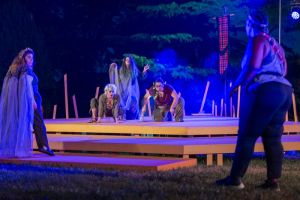Even More Supernatural Macbeth at Delaware Shakespeare
Hot- Macbeth
- by William Shakespeare
- Delaware Shakespeare Festival
- July 21 - August 6, 2023
| Acting |  |
| Costumes |  |
| Sets |  |
| Overall |  |
Delaware Shakespeare’s Macbeth is a proudly non-traditional production: from its special effects, to its story additions and alterations, to its diverse cast representing the Global Majority and a spectrum of LGBTQIA experiences (definitely a welcome and much-needed break with tradition). At the same time, their take on Macbeth maintains much of the play’s core ideas, re-examining its themes and assumptions in unexpected ways.
Appropriately, Scenic Designer Marie Laster sets the stage for the production’s subversion of expectations by providing the dark play with two colorful polygonal platforms: one a cheerful golden yellow, the other institutional green. Crooked slats line the back of each platform, like fencing not quite tall enough to keep anyone – or anything – out. The banners of the reigning king hang (however briefly) behind the golden stage, while a handful of stylized bunches of fronds decorated with colorful patterns surround the green stage and give the somewhat baffling impression that someone has yarn-bombed Birnam Wood.
Anna Sorrentino’s costume design likewise reverses some expectations. Most of the human characters have only a few token accessories to differentiate their different stations or affiliations, like the tartan sashes – Black Watch for Duncan’s reign, a variation of Jacobite Old Sett for Macbeth’s – that mark their loyalty (or lack thereof) to the current king. Underneath, they all stick to a basic uniform of black or dark grey sleeveless shirts, leggings, and shoes. (Sometimes too basic a uniform, leaving the impression that the cast has rolled up in their own workout clothes; it gives the production a more slip-shod appearance that does not match the care put into its other aspects.) The witches, meanwhile, appear in natural but still colorful shades like aubergine, lavender, and olive; the variety of different cuts and drapes, as well as their eerie face paint, gives each of them a distinct aesthetic. Lady Macbeth stands out in a simple but eye-catching cerulean dress, which boldly sets off the golden crown and tartan cape she dons as queen.
The hallmark of Mariah Ghant’s Macbeth is his public sincerity, which Ghant impressively imbues with the utmost warmth and conviction even while Macbeth is lying through his teeth. Ghant demonstrates the cost of maintaining this facade: when Macbeth struggles to conquer his emotions in front of an audience, he falls back on parade rest no matter how civilian the occasion; when he struggles to conquer his emotions in private, he falls apart completely. Even then Ghant emphasizes the sincerity of his grief and self-loathing, while making it abundantly clear that he has no intention of heeding them. Ciera Gardner, meanwhile, gives Lady Macbeth a self-confident brashness that is so pervasive it takes supernatural intervention at Banquo’s banquet to expose it too as a front – and even then, only because it caught her sleeping. Lady Macbeth is the more openly dominant partner, but Ghant and Gardner’s performances suggest the pair are linked because they understand what is truly going on beneath their spouse’s pretenses.
Other strong performances add new dynamics to the play. Zach Valdez brings considerable warmth and charm to Banquo – people skills which Valdez shows as a serious threat to Macbeth when Banquo starts taking charge and providing strong leadership after the murder of Duncan (Katherine Perry). Perry’s Duncan is affable but politically astute, and Perry and Gardner transform the meeting between Duncan and Lady Macbeth in Act I, Scene 4 into a delightfully sharp-edged battle of wills. Perry is also double-cast as Hecate – or perhaps Duncan is double-cast as Hecate, as the production’s extensive supernatural motifs blur the lines between characters, reality, and death itself. Perry joins CJ Higgins, Kimie Muroya, and Rachel O’Hanlon-Rodriguez as the three witches, delivering energetic and unsettling performances as the sinister influence behind the play’s action. Part of this involves the witches and Hecate assuming the roles of minor characters, like the drunken Porter or Lady Macbeth’s doctor, allowing them to directly interact with the main storyline. Perry, Higgins, Muroya, and O’Hanlon-Rodriguez do an excellent job with the layered performances, producing impersonations who seem believably human to the other characters while slyly emphasizing all the dramatic irony of their eldritch intentions.
These supernatural tricksters steal the show (often quite literally), but director AZ Espinoza never lets the production’s transformative elements overwhelm the action. Many are drawn directly from the text itself, like the composite characters or Macbeth’s phantom dagger. Others expand upon elements from the original: Lady Macbeth’s descent into madness proves equally interesting when it is touched off by the very kind of spirits she attempted to summon and ends with a Bergmanesque danse macabre as her spirit is dragged away to an unknown fate. Espinoza and Lighting Designer Calvin Anderson imbue these sequences with stylish flair, flooding the stages with brilliant colors and spotlighting the column of smoke representing the witches’ cauldron. The sound effects are equally well-deployed, filled with unnerving screeching distortions. Sound Designer/Composer Michael Hahn provides a driving soundtrack, veering between ominous percussion and Celtic-inspired marches, and in a delightfully clever move, plays sections of the songs backwards so that any Satanic messages in the music can sync up with the supernatural happenings onstage. Espinoza balances these many flashy elements with an even hand and a steady pace that builds to a relentless conclusion.
Historical tradition held that James I – the reigning monarch when Macbeth was written – was descended from Banquo, and theatrical tradition demanded that even tragedies had to end with an attempt to restore the social order. Needless to say, Delaware Shakespeare is not under the same pressure as The King’s Men to portray the succession of the King of England and reinforce the legitimacy of the Golden Chain; their version ends with the witches ascendant. The strength of their production, however, is that it leaves the audience questioning whether or not that’s truly such a deviation from the text. Delaware Shakespeare’s lively and creative Macbeth has many surprises, but none greater than how its changes make it in some ways an even more faithful adaptation.
Discuss this review or play in our forums
Reviews on this site are subject to this required disclosure.













